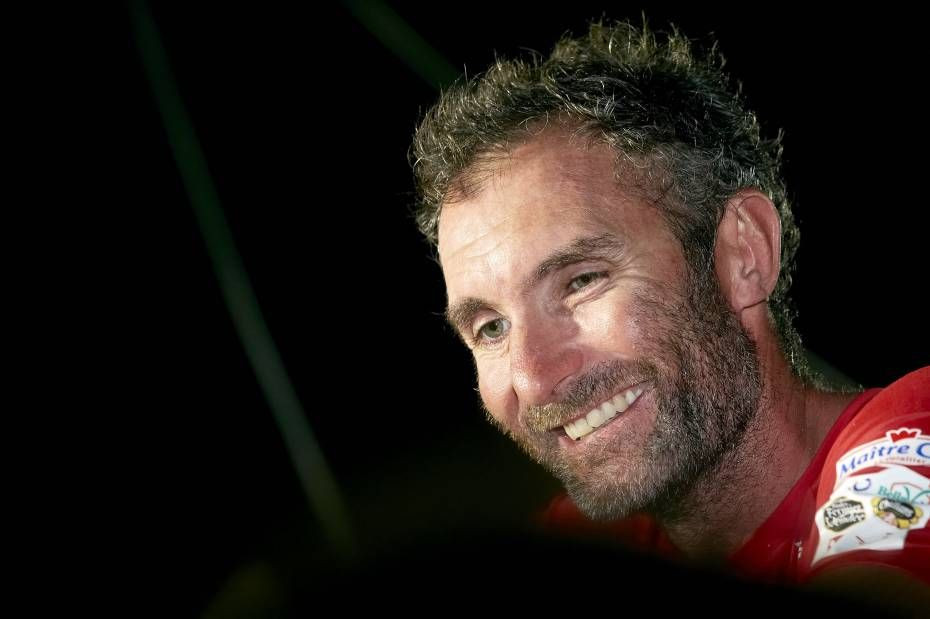Jérémie Beyou: “the leaders’ trajectory is a mark of complete mastery”

After his forced retirement in the Transat Jacques Vabre, Maître CoQ skipper Jérémie Beyou agreed to review the lessons learned from this first week of racing. Breakages of course, but also the leaders’ skill in trajectories, new boats, and foils. A no-nonsense interview.
The first week’s weather conditions
“Making the right decision is never easy. But we felt our voices were simply not being heard by the organiser and race management. We knew the conditions were borderline for our boats. Of course some people say we’ll be doing a round the world in such conditions, but the big difference is that in the Southern Ocean you hit the bad weather when you’re sailing downwind and you can manoeuvre out of a situation like that. When we left Le Havre, we had no escape. Between race management and the delegation of racers who had come along, we just couldn’t get our message across.
Aboard Maître CoQ, our decision to retire was based on the on-coming weather conditions. Given our technical issues we didn’t want to risk seriously compromising the next stage of our programme by crossing swords with what was forecast.”
The trajectories of the front-runners
“First of all you have to imagine what sailing close-hauled on an IMOCA 60 is like. The inside of the boats are ever starker and it’s increasingly difficult to make a space for yourself in the cabin. Just getting in front of the computer and clicking the mouse takes intense effort. The boat bounces every which way and it’s really full-on. Managing to etch out a trajectory close to perfection in such circumstances is a challenge and a half. I’m aware of the level of preparation and the expertise of the three front-runners, but I still can’t help being in awe of their performance. Let’s not forget, that in other series’ like the Ultimes or the Multi50s, the racers have an onshore router. Yann and Charlie’s trajectory is exemplary and they have been able to position themselves perfectly in relation to the centre of the low-pressure zone. On top of that the northerly route had the toughest seas, although as we’ve seen that those who opted for the southern route weren’t spared either.”
The rhythm
“Those behind the weather front have had to sail in an active storm system and they haven’t eased off the pace for even a second. They had no choice but to attack, slamming into the waves in boat-breaking seas in order to clear a ridge of high pressure that was forming across their path. In times like that, resting is not an option. If you get out of sync, you lose the race.”
The initial analysis of the foils
“Before the breakage, Edmond de Rothschild and Safran showed that they were quick. Right now, you can see the speed differential between Banque Populaire VIII and her two adversaries. If I were in Armel’s place, I’d be smiling. Knowing you can knock your most dangerous rivals off the throne with pure speed is an incredible advantage. I think the foilers will obviously remain in this configuration. As for the others, we find ourselves in the situation I feared we might during the measurement meetings: in order to be competitive, we’ll need to undergo a massive refit during the Vendée Globe year.”
Breakage
“The analysis is severe for sure. That said, let’s not confuse everything. The fleet was not designed for such conditions: several boats were in the development phase and we know how tough it is to achieve top performance on an IMOCA 60 given how complicated these machines are to optimise and make reliable. On top of that, I think two forces are at play here aboard the new boats: on the one hand, the boat does not handle in the same way – when you’ve sailed a multihull you understand that very quickly: when the boat rises up on her foils, you have to handle her smoothly and not use a pedal to the floor approach. Sailing these boats is much more refined than on a classic monohull. Secondly, I think perhaps the naval architects were over-keen to make the boats lighter: as you can no longer play with the keel and the mast (which, incidentally, were entirely satisfactory in terms of reliability), perhaps we made the boats too light.”
The future
“Personally I’m very keen to do the Transat Saint-Barth – Port-la-Forêt. It resembles what we’re likely to encounter on the Vendée Globe and it’s an excellent trial run in solo configuration. Right now, it all depends on my team and the decisions we take in terms of a refit. Currently we have quite an efficient way of operating: I express my wishes as a sailor and together we decide if it’s reasonable according to our technical capabilities.”
Teams info
ALL ACCESS #5 with Yoann Richomme
On May 6th, Yoann Richomme, skipper of Paprec Arkéa, crossed the finish line of The Transat CIC in first place, creating a memorable moment not only for himself but also for the entire team who worked tirelessly to achie…
•••IMOCA and 11th Hour Racing join forces to promote sustainable innovation and diversity
To support its work on sustainability and inclusion, the IMOCA Class today announced a new partnership with US-based 11th Hour Racing.
•••